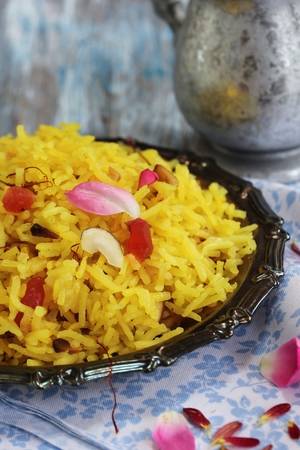Food story by Indo-Islamic Culture
Zarda is a traditional dessert of Indian subcontinent that is also popular among the locals as Meethe Chawal (Sweet Rice). It has been prepared by boiling rice, & adding flavors by the colors, milk, sugar, cardamoms, raisins, saffron, Pistachios, & almonds. The word Zarda ( زردہ) is derived from the Persian word “Zard” that means yellow color. It’s the traditional yellow color of the sweet rice (Zarda) that gave this name. Historically the tradition of sweet rice (Meethe Chawal) was quite common in rural Punjab & other provinces of North India where Jaggery is used to sweeten the rice (Gur Chawal). It seems that in historical time line, the Zarda is popularized in North India by Mughals. The Ain-I-Akbari of Abul Fazal explains the recipe of Zard Birinj, which constitutes rice, Sugar, nuts, Saffron, Cinnamon, & even ginger also.

Lizzie Collingham in her book “Curry : a tale of cooks and conquerors, 2006”noted ‘zard biranj‘, the original food that seems to be evolved to the modern day zarda.“Many of the recipes, like the one for zard biranj, used large quantities of raisins and pistachios. Combinations of meat and dry fruit were common in Persian dishes. Cartloads of sultanas, dried apricots, figs, and almonds were imported into India along the new roads that were constructed to facilitate trade throughout northern India, central Asia, and Persia, Curry: a tale of Cook & conquerors”.

Recipe for the Zard Birinj from Ain-I-Akbari by Akbar’s Courtier Abul Fazal, Reference: Curry : a tale of cooks and conquerors by Collingham, E. M., 2006, Oxford, University Press, Oxford, Newyork
10 seers of the rice; 5 seers of the sugar, 31/2 seers of Ghee, Raisins, almonds, Pistachios (1/2 seer of each); 1/8 seer of fresh ginger, 11/2 dams of saffron, 21/2 misqals of cinnamon. This will make four ordinary dishes.
One seer was equivalent to about 21/2 lb, & a dam was about 3/4oz. 1 misqal = 6.22 grams)

In recent time, it seems that the word “Zarda” is more familiar among traditional Urdu speaker that mainly constitute Muslims where as in general Hindi speaking population it’s quite popular as Meethe Chawal. The book “complete guide to Sikhism by Jagraj Singh” cited Kheer, Kadha Prasad & Zarda (Yellow colored sweet rice) are the favorite sweet dishes of Sikhs. In modern times, the yellow zarda is also a common offering as a dessert at Sufi shrines all across the subcontinent.
Even many towns of Western UP, the road side pulao/Biryani sellers used to add the small amount of Zarda within a plate of Biryani. It gave a special flavor by mixing sweet rices with spicy & salty biryani. From the North Indian cities & small towns to the Deccan Hyderabad, the Zarda is a popular homemade dessert during festivals & occasions such as marriage & birth ceremonies. In neighboring Pakistan also, the “Zarda” has a special status in terms of its presence in celebratory occasions. An article by NDTV also quoted its relevance in Indian socio-cultural context.
Be it Godh Bharai ceremony, Karva Chauth, Shaadi, Raksha Bandhan, Diwali, Sankranti or Janmashtami, this sweet treat is lovingly prepared, particularly in North Indian households and relished by all. Loaded with dry fruits and nuts, and scented with gulab jal or rose water and saffron, it is hard to resist.
Festive Special: How to Make Meethe Chawal , NDTV Food desk, 2017. Retrieved from:
https://food.ndtv.com/food-drinks/festive-special-how-to-make-meethe-chawal-1759385
This article has been provided by IndoIslamic Culture. A handle on Twitter & Facebook managed by a Pediatrician & history enthusiast who share syncretic beauties of South Asian History.
